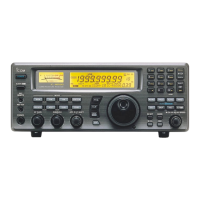Then the RF signals from the
switching
diode
(D17) are
applied
to the 1 st mixer circuit
•
Bandpass filters
Receive freq.
{MHz]
SW
diode
BPF lelect
signal
Components
0.1- 0.49999
D3
B1 L7.L8. C15-C17
0.5-
1.59999 D3 B2
LIO.
L11.C22-C25
1.6-
1.99999
D7 B3 L23, L24,
C42-C44
2.0-
3.99999 D8
B4
L18-L20. C34-C39
4.0-
7.99999
D8
B5 L26-L29, C46-C51
8.0-10.99999
D9 Be
L31-U3.
C54-C59
11.0-14.99999
D9
B7 L36-L38. C62-Ce7
15.0-21.99999
DIO B8 L41-L43,
C70-C75
22.0-29.99999
DIO B9
L46-L49.
C79-C84
4-1-8
HF 1ST MIXER CIRCUIT
(RF-A UNIT)
The
1st
mixer
circuit
converts
the RF signals to
a desired
48.8 MHz 1st IF signal.
In
this
way,
the VCO-A circuit
output
frequencies
are used for 1 st
LO
signals after
being
amplified at the LO amplifier
(IC2).
The received
RF
signals
from the bandpass filter
circuit are
mixed with 1st LO signals at the
1st mixer circuit
(06, Q7)
after
passing
through
the low-pass
filter circuit
(LS9,
C98-C100). The mixed 1st IF signal
is
passed through the
crystal filter
(FI1) to suppress out-of-band
signals then
amplified
at
the
IF amplifier circuit
(Q8).
The amplified
1st
IF
signal is applied
to the 2nd mixer
circuit.
•
1st LO frequency and
1st IF frequency
4-1-10
IF CIRCUIT (MAIN UNIT)
The 10.7
MHz 2nd
IF
signal
from the
MIX unit
Is
applied
to
the mode
switch
(D3) after being amplified
at
the IF
ampli-
fier
circuit
(Q2).
However,
the 10.7 MHz 2nd IF signal
from
the
RF-A unit is applied
to the mode switch
(D3) directly.
The
IF signal from the mode
switch
is then applied to
a
different
circuit
depending
on the receiving
mode.
(1)
WFM
mode
The 2nd IF signal
from the
mode switch (D3) is applied
to
the
IF amplifier circuit
(Q4).
The amplified
IF signal
is
passed through
the bandpass
fillers (Fll, FI2) to
suppress
out-of-band signals.
The filtered
IF signal is
then applied to
the WFM
demodulator
circuit.
(2)
Other
modes
The
2nd IF sign
2U from the mode switch
(D3) is passed
through
the bandpass filter
(FI3)
to
suppress
out-of-band
signals, and then
applied
to the IF amplifier circuit
(Q15).
The amplified
IF signal
Is then applied
to the
3rd mixer
circuit.
4-1-11
3RD
MIXER CIRCUIT
(MAIN
UNIT)
The 3rd mixer circuit
mixes the 2nd
IF signal
and 3rd
LO
signal to produce
a 455 kHz 3rd IF
signal.
The 3rd
LO
signal
is generated
at the DOS circuit
(PLL unit,
IC1
3)
and
is applied
to
the
3rd mixer
circuit via the buffer-amplifier
(Q28).
The
2nd IF signal from the IF
amplifier
circuit
(Q15)
is
applied
to the
3rd
mixer
circuit
(IC6,
pin
6),
and
also
the 3rd
LO
signal
(10.245 MHz) Is applied
to pin
8
of the
1C. The
mixed
3rd IF signal is
output from
pin
3,
and is passed
through
different
bandpass fillers
depending
on the receiv-
ing mode
and passband
width. The
filtered
3rd IF signal is
applied
to the matched
demodulator circuit
with the receiv-
ing
mode via the
IF amplifier circuit
(016).
Receive freq. [MHz] 1st
LO freq. [MHz]
1st IF freq.
[MHz]
0.1-29.99999
48.9-78.79999
46.8
4-1-9
HF 2ND MIXER
CIRCUIT (RF-A UNIT)
The 2nd
mixer circuit converts
the 1st
IF
signal
to the
desired 10.7 MHz
2nd IF frequency. The
2nd
LO signal is
used
in the mixer circuit
to produce
a 2nd IF frequency,
and
the signal is generated at the
VCO-B circuit
(VCO-B board,
Q1
.
Q3)
after
being amplified
at
the
LO amplifier
(IC1 ).
•
Bandpass filter
selection
Mode(s)
Bandpass
fitters)
Passband width
FM. AM-W
FI7.
R6
12 kHz
FM-N,
AM FIS. R6
5.5 kHz
SSB,
CW. AM-N
FI4
2.2 kHz
CW-N
Optional FL-52A
500
Hz
4-1-12
DEMODULATOR
CIRCUIT
(MAIN UNIT)
The
1st
IF signal from
the IF amplifier
(Q8)
is applied to the
The
demodulator circuit
converts the
3rd IF signal
into
AF
signals.
4 separate
demodulator
circuits are
employed
for
4-3

